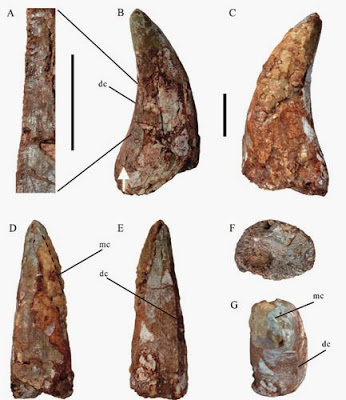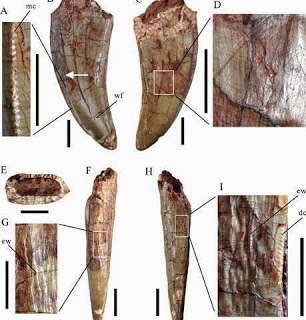
Large carnivorous dinosaurs, are common in the Late Cretaceous of Asia, but only some fragment teeth have been recovered from southern China. In a paper published in the latest issue of Vertebrata PalAsiatica, Dr. XU Xing, Institute of Vertebrate Paleontology and Paleoanthropology (IVPP) of the Chinese Academy of Sciences, and MO Jinyou, Natural History Museum of Guangxi in Nanning reported two isolated, large predatory theropod teeth from the Upper Cretaceous of southern China. The smaller tooth is assigned to a tyrannosaurid, whereas the larger one is greatly distinct from other known Late Cretaceous theropods, probably represents a previously unrecognized large predatory dinosaur.
These large predatory theropod teeth were discovered for the first time from the Upper Cretaceous Nanxiong Formation of Jiangxi, helping better understand the known diversity of vertebrates from the Upper Cretaceous Nanxiong Formation, southern China.
The crown height of the smaller tooth is 76 mm. It is identified as a typical tooth of a large tyrannosaurid based on large and suboval in cross-section. The crown base ratio, about 0.72, is within the range seen in Tyrannosaurus rex, and the chisel-shaped distal denticles are similar to those of tyrannosaurids.
The larger tooth is moderately laterally compressed, with well defined longitudinal oriented enamel wrinkles at the basal halves of the mesial and distal margins. The crown height of the larger tooth is 91 mm. It probably represents a previously unknown large theropod inhabited Asia during the Late Cretaceous.
The Nanxiong Formation or its equivalents are exposed in several provinces of southeastern China and represented by a thick sequence of red mudstones, sandstones and conglomerates. In Jiangxi, these red beds have yielded dinosaurs and other vertebrate fossils since 1965, including turtles, lizards, dinosaur eggs, small theropods, and sauropods.
This work was supported by the National Natural Science Foundation of China.

Reference:
Large theropod teeth from the Upper Cretaceous of Jiangxi, southern China: www.ivpp.cas.cn/cbw/gjzdwxb/xbwzxz/201501/P020150112592082762393.pdf
Note : The above story is based on materials provided by Chinese Academy of Sciences.










